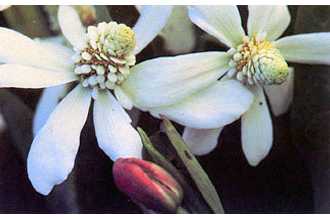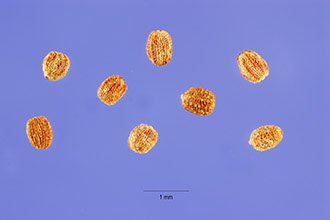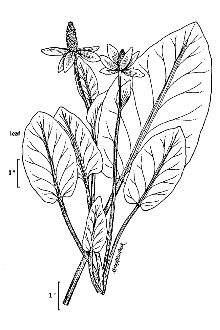Yerba Mansa
Scientific Name: Anemopsis californica (Nutt.) Hook. & Arn.

| General Information | |
|---|---|
| Usda Symbol | ANCA10 |
| Group | Dicot |
| Life Cycle | Perennial |
| Growth Habits | Forb/herb |
| Native Locations | ANCA10 |
Plant Guide
Alternate Names
Bear root
Uses
Ethnobotanic: The root of the plant was used as a medicine by many tribes in California, Great Basin, and the Southwest including the Wukchumni Yokuts, Kawaiisu, Paiute, Shoshone, and Pima. Some Native Americans still gather the plant today. The Kawaiisu, for example, boiled the root and a decoction was then drunk hot to alleviate colds and coughing. The Tubatulabal of southern California for colds also took a decoction of the plant. The Kamia of Imperial Valley pulverized the seeds of yerba mansa in the mortar and the meal was then cooked as mush in a pot or baked as bread in hot ashes. The Yokuts pounded up the root and soaked it in water. The water was then drunk for a bad stomach. The Costanoan made a decoction from the root, which was used, for menstrual cramps and for general pain remedy. A tea was used to wash sores and the plant, dried and powdered, was sprinkled on wounds as a disinfectant. The Cahuilla peeled, cut up, squeezed, and boiled the roots into a decoction that was drank as a cure for pleurisy. An infusion was also used as a cure for stomach ulcers, chest congestion, and colds. The bark was also harvested in autumn and boiled into a deep red-wine color and drank to alleviate ulcers or applied externally to wash open sores. The Moapa Paiute boiled the leaves in a quantity of water and used it as a bath for muscular pains and for sore feet. The Shoshone mashed the roots and boiled them to make a poultice for swellings, or the decoctions used as an antiseptic wash. A tea from the boiled roots can be taken for stomachache or more commonly as a tonic for general debility following colds. The Pima in the Southwest made an infusion of dried roots which was taken for colds. They also chewed the roots and swallowed them or made a decoction of the roots which was taken for coughs. Spanish settlers in California used the plant as a liniment for skin troubles and as a tea for disorders of the blood. Alfred Brousseau © Brother Eric Vogel, St. Mary's College @ CalPhotos
Status
Please consult the PLANTS Web site and your State Department of Natural Resources for this plant’s current status and wetland indicator values.
Description
General: Lizard’s Tail Family (Saururaceae). This common herbaceous perennial has an aromatic, creeping rhizome, which is thick and woody. The flowers do have not true petals, but rather each flower is subtended by an involucre bract 1-3 cm long that is white, often tinged reddish. There are about one hundred flowers to each conical-shaped flower head. The conical spike is stout, 1-3 cm long and is subtended by 4-8 unequal white petal-like bracts, 1-2 cm long and rounded. The fruit is a capsule. The leaves have a spicy smell and are alternate and simple.
Distribution
For current distribution, please consult the Plant Profile page for this species on the PLANTS Web site, Use soil moisture sensors to measure the soil moisture of Yerba Mansa., The plants are found in saline or alkaline soil in damp or wet places in many different plant community types, such as valley grassland, saltgrass flats, and desert fan palm oases, The range of the plant is from the Peninsular Ranges, South Coast Ranges and Mojave Desert of California on the south, and north through the Sacramento, San Joaquin Valleys and San Francisco Bay Area, The plant also inhabits the Channel Islands off the southern California coast, Its range extends into Utah, central Kansas, northcentral Oklahoma, Colorado at the foot of the Front Range, Arizona, northwest New Mexico, and west Texas
Establishment
This plant is not valued horticulturally, yet its white bracts are quite attractive. This plant is hardy and spreads rapidly, and can become invasive. Start the plant from a fleshy root. Dig up the plants from an already established area and transplant them in the fall or winter. Directly outplant the plants in the ground in full sun, giving them plenty of space. Place the plants one-foot apart. The transplants will fill in quickly, sending 2-3 feet of runners radiating out from each plant. Water the transplants and keep them moist year round. If growing the plants for their roots for medicinal purposes, plant them in a loose soil.
Management
Weed around the plants periodically. Areas of yerba mansa were burned periodically by the Wukchumni Yokuts to maintain their quality and abundance. Cultivars, Improved and Selected Materials (and area of origin) ANCA is available from native plant nurseries within its range.
Plant Traits
Growth Requirements
| Temperature, Minimum (°F) | 22 |
|---|---|
| Adapted to Coarse Textured Soils | No |
| Adapted to Fine Textured Soils | Yes |
| Adapted to Medium Textured Soils | Yes |
| Anaerobic Tolerance | High |
| CaCO3 Tolerance | High |
| Cold Stratification Required | No |
| Drought Tolerance | None |
| Fertility Requirement | Low |
| Fire Tolerance | High |
| Frost Free Days, Minimum | 280 |
| Hedge Tolerance | None |
| Moisture Use | High |
| pH, Maximum | 9.0 |
| pH, Minimum | 6.5 |
| Planting Density per Acre, Maxim | 4800 |
| Planting Density per Acre, Minim | 2700 |
| Precipitation, Maximum | 18 |
| Precipitation, Minimum | 6 |
| Root Depth, Minimum (inches) | 6 |
| Salinity Tolerance | Medium |
| Shade Tolerance | Intolerant |
Morphology/Physiology
| After Harvest Regrowth Rate | Slow |
|---|---|
| Toxicity | None |
| Resprout Ability | No |
| Shape and Orientation | Erect |
| Active Growth Period | Spring and Summer |
| Bloat | None |
| C:N Ratio | Low |
| Coppice Potential | No |
| Fall Conspicuous | No |
| Fire Resistant | No |
| Flower Color | White |
| Flower Conspicuous | Yes |
| Foliage Color | Green |
| Foliage Porosity Summer | Porous |
| Foliage Porosity Winter | Porous |
| Fruit/Seed Color | Brown |
| Nitrogen Fixation | None |
| Low Growing Grass | No |
| Lifespan | Long |
| Leaf Retention | No |
| Known Allelopath | No |
| Height, Mature (feet) | 1.5 |
| Growth Rate | Moderate |
| Growth Form | Rhizomatous |
| Fruit/Seed Conspicuous | No |
| Foliage Texture | Coarse |
Reproduction
| Vegetative Spread Rate | Moderate |
|---|---|
| Small Grain | No |
| Fruit/Seed Abundance | High |
| Seedling Vigor | Medium |
| Seed Spread Rate | Moderate |
| Propagated by Tubers | No |
| Propagated by Sprigs | Yes |
| Propagated by Sod | No |
| Propagated by Seed | Yes |
| Propagated by Cuttings | No |
| Propagated by Container | No |
| Propagated by Bulb | No |
| Propagated by Bare Root | No |
| Fruit/Seed Persistence | No |
| Fruit/Seed Period End | Spring |
| Fruit/Seed Period Begin | Spring |
| Commercial Availability | Routinely Available |
| Bloom Period | Early Spring |
| Propagated by Corm | No |
Suitability/Use
| Veneer Product | No |
|---|---|
| Pulpwood Product | No |
| Post Product | No |
| Palatable Human | No |
| Nursery Stock Product | No |
| Naval Store Product | No |
| Lumber Product | No |
| Fodder Product | No |
| Christmas Tree Product | No |
| Berry/Nut/Seed Product | No |


